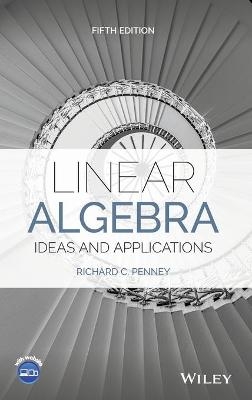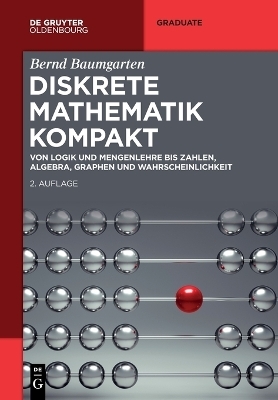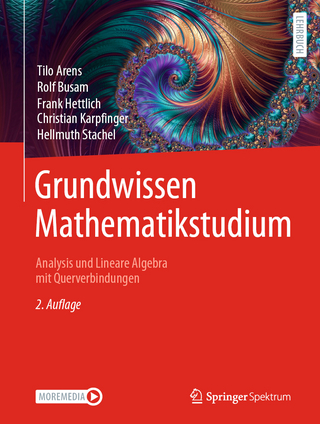
Linear Algebra
Wiley-Blackwell (Verlag)
978-1-119-65692-0 (ISBN)
"This volume is ground-breaking in terms of mathematical texts in that it does not teach from a detached perspective, but instead, looks to show students that competent mathematicians bring an intuitive understanding to the subject rather than just a master of applications." - Electric Review
Learn foundational and advanced topics in linear algebra with this concise and approachable resource
A comprehensive introduction, Linear Algebra: Ideas and Applications, Fifth Edition provides a discussion of the theory and applications of linear algebra that blends abstract and computational concepts. With a focus on the development of mathematical intuition, the book emphasizes the need to understand both the applications of a particular technique and the mathematical ideas underlying the technique.
The book introduces each new concept in the context of explicit numerical examples, which allows the abstract concepts to grow organically out of the necessity to solve specific problems. The intuitive discussions are consistently followed by rigorous statements of results and proofs. Linear Algebra: Ideas and Applications, Fifth Edition also features:
- A new application section on section on Google's Page Rank Algorithm.
- A new application section on pricing long term health insurance at a Continuing Care Retirement Community (CCRC).
- Many other illuminating applications of linear algebra with self-study questions for additional study.
- End-of-chapter summaries and sections with true-false questions to aid readers with further comprehension of the presented material
- Numerous computer exercises throughout using MATLAB (R) code
Linear Algebra: Ideas and Applications, Fifth Edition is an excellent undergraduate-level textbook for one or two semester undergraduate courses in mathematics, science, computer science, and engineering. With an emphasis on intuition development, the book is also an ideal self-study reference.
RICHARD C. PENNEY, PHD is Emeritus Professor in the Department of Mathematics and former Director of the Mathematics/Statistics Actuarial Science Program at Purdue University. He has authored numerous journal articles, received several major teaching awards, and is an active researcher. He received his graduate education at MIT.
1 Systems of Linear Equations 1
1.1 The Vector Space of m x n Matrices 1
The Space R n 4
Linear Combinations and Linear Dependence 6
What Is a Vector Space? 10
Exercises 16
1.1.1 Computer Projects/Exercises/Exercises 21
Introduction to MATLAB 21
1.1.2 Applications to Graph Theory I 24
Exercises 26
1.2 Systems 27
Rank: The Maximum Number of Linearly Independent Equations 33
Exercises 37
1.2.1 Computer Projects/Exercises 39
The Translation Theorem 39
1.2.2 Applications to Circuit Theory 40
Exercises 44
1.3 Gaussian Elimination 45
Spanning in Polynomial Spaces 56
Computational Issues: Pivoting 59
Exercises 60
Computational Issues: Flops 65
1.3.1 Computer Projects/Exercises 66
Using tolerances in rref and rank 66
1.3.2 Applications to Traffic Flow 69
Exercises 70
1.4 Column Space and Nullspace 71
Subspaces 73
Exercises 82
1.4.1 Computer Projects/Exercises 90
The null Command 90
Chapter Summary 92
2 Linear Independence and Dimension 93
2.1 The Test for Linear Independence 93
Bases for the Column Space 99
Testing Functions for Independence 102
Exercises 104
2.1.1 Computer Projects/Exercises 108
Changing Pivot Columns 108
2.2 Dimension 109
Exercises 118
2.2.1 Computer Projects/Exercises 124
2.2.2 Applications to Differential Equations 125
Exercises 128
2.3 Row Space and the rank-nullity theorem 128
Bases for the Row Space 130
Computational Issues: Computing Rank 138
Exercises 140
2.3.1 Computer Projects/Exercises 144
Random Matrices of a given Rank 144
Chapter Summary 145
3 Linear Transformations 147
3.1 The Linearity Properties 147
Exercises 154
3.1.1 Computer Projects/Exercises 159
2-D Computer Graphics 159
3.2 Matrix Multiplication (Composition) 161
Partitioned Matrices 168
Computational Issues: Parallel Computing 170
Exercises 171
3.2.1 Computer Projects/Exercises 176
3-D Computer Graphics 176
3.2.2 Applications to Graph Theory II 177
Exercises 179
3.2.3 Computer Projects/Exercises 179
Google's Page Rank Algorithim 179
Exercises 182
3.3 Inverses 183
Computational Issues: Reduction versus Inverses 189
Exercises 191
3.3.1 Computer Projects/Exercises 196
Ill-Conditioned Systems 196
3.3.2 Applications to Economics: The Leontief open model 198
Exercises 203
3.4 The LU Factorization 204
Exercises 213
3.4.1 Computer Projects/Exercises 215
Row Exchanges in the LU Factorization 215
3.5 The Matrix of a Linear Transformation 216
Coordinates 216
Isomorphism 227
Invertible Linear Transformations 228
Exercises 230
3.5.1 Computer Projects/Exercises 234
Graphing in Skewed-Coordinates 234
3.5.2 Computer Projects/Exercises 236
Pricing Long Term Health Care Insurance 236
Exercises 240
Chapter Summary 241
4 Determinants 243
4.1 Definition of the Determinant 243
4.1.1 The Rest of the Proofs 251
Exercises 254
4.1.2 Computer Projects/Exercises 257
4.2 Reduction and Determinants 257
Uniqueness of the Determinant 262
Exercises 265
4.2.1 Volume 267
Exercises 270
4.3 A Formula for Inverses 270
Cramer's Rule 272
Exercises 275
Chapter Summary 276
5 Eigenvectors and Eigenvalues 279
5.1 Eigenvectors 279
Exercises 288
5.1.1 Computer Projects/Exercises 291
Computing Roots of Polynomials 291
5.1.2 Application to Markov Chains 292
Application to the Auto Rental Business 292
Exercises 294
5.2 Diagonalization 296
Powers of Matrices 298
Exercises 299
5.2.1 Application to Systems of Differential Equations 301
Exercises 304
5.3 Complex Eigenvectors 304
Complex Vector Spaces 311
Exercises 312
5.3.1 Computer Projects/Exercises 314
Complex Eigenvalues 314
Exercises 314
Chapter Summary 314
6 Orthogonality 317
6.1 The Scalar Product in R n 317
Orthogonal/Orthonormal Bases and Coordinates 321
Exercises 325
6.2 Projections: The Gram-Schmidt Process 327
The QR Decomposition 333
Uniqueness of the QR-factorization 336
Exercises 337
6.2.1 Computer Projects/Exercises 340
The Least Squares Solution 340
6.3 Fourier Series: Scalar Product Spaces 342
Exercises 348
6.3.1 Computer Projects/Exercises 352
Plotting Fourier Series 352
6.4 Orthogonal Matrices 353
Householder Matrices 359
Exercises 363
Discrete Wavelet Transform 366
6.4.1 Computer Projects/Exercises 367
6.5 Least Squares 369
Exercises 375
6.5.1 Computer Projects/Exercises 379
Finding the Orbit of an Asteroid 379
6.6 Quadratic Forms: Orthogonal Diagonalization 380
The Spectral Theorem 383
The Principal Axis Theorem 384
Exercises 390
6.6.1 Computer Projects/Exercises 393
The Principal Axis Theorem 393
6.7 The Singular Value Decomposition (SVD) 394
Application of the SVD to Least-Squares Problems 400
Exercises 402
Computing the SVD Using Householder Matrices 404
Diagonalizing Symmetric Matrices 406
6.8 Hermitian Symmetric and Unitary Matrices 408
Exercises 414
Chapter Summary 417
7 Generalized Eigenvectors 419
7.1 Generalized Eigenvectors 419
Exercises 427
7.2 Chain Bases 430
Jordan Form 436
Exercises 442
The Cayley-Hamilton Theorem 443
Chapter Summary 444
8 Numerical Techniques 445
8.1 Condition Number 445
Norms 445
Condition Number 447
Least Squares 450
Exercises 450
8.2 Computing Eigenvalues 451
Iteration 451
The QR Method 455
Exercises 461
Chapter Summary 462
Answers and Hints 464
Index 489
| Erscheinungsdatum | 23.03.2021 |
|---|---|
| Verlagsort | Hoboken |
| Sprache | englisch |
| Maße | 157 x 231 mm |
| Gewicht | 907 g |
| Einbandart | gebunden |
| Themenwelt | Mathematik / Informatik ► Mathematik |
| ISBN-10 | 1-119-65692-3 / 1119656923 |
| ISBN-13 | 978-1-119-65692-0 / 9781119656920 |
| Zustand | Neuware |
| Informationen gemäß Produktsicherheitsverordnung (GPSR) | |
| Haben Sie eine Frage zum Produkt? |
aus dem Bereich


